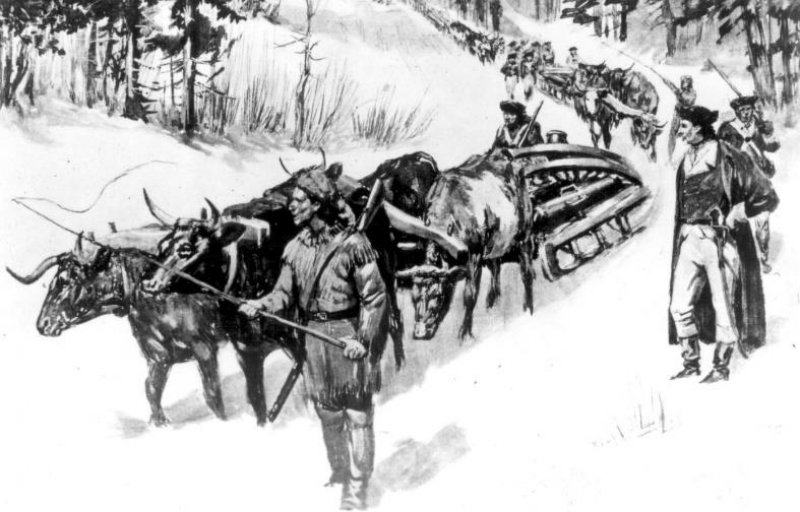One of the iconic stories of the American Revolution is the laborious trek of a contingent of newly- minted patriots, led by Henry Knox, lugging cannon from Ft Ticonderoga to Dorchester Heights, forcing the British to abandon Boston, an important early victory is our long fight for freedom. Few may realize that important decisions while the expedition was in Saratoga County were key to the success of the mission.
In 1775, the Continental Army had to contend with the issue of Boston. The British had taken control of the city, and with their navy stationed in Boston Harbor, they were too formidable to be easily forced out. The only way for the Continental Army to stand a chance was to counter the British artillery with their own.
Luckily, the Continental Army had recently come into possession of a number of cannons from the capture of Fort Ticonderoga, a British fort on Lake Champlain. Not so luckily, Fort Ticonderoga sat nearly 250 miles away from Cambridge, MA, where the artillery was needed.
The solution to this problem came in the person of Henry Knox. Earlier that year George Washington had welcomed Knox into his inner circle and helped him get promoted to the rank of colonel shortly thereafter. Knox was barely 25 and had no formal education in military tactics, but despite this, he was the man Washington chose to get the cannons from Ticonderoga to Cambridge. He arrived at Fort George, which sat on the southernmost tip of Lake George, on December 4th, after departing from New York City and following the Hudson River up. His brother, William, traveled with him, and Major General Philip Schuyler provided Knox with instruction and aid throughout the process. The next day, they arrived at Fort Ticonderoga after sailing the 33 miles up Lake George. There, Knox found that there was nearly 120,000 pounds of artillery that needed to be transported.
December 9 began the long, arduous journey to Cambridge. While the party journeyed back down Lake George, one of the boats, which was carrying the majority of the artillery, ran aground and had to be refloated before it made it to Fort George. The group then slowly made its way south. Initially, sleds and oxen to pull them were to be procured by George Palmer, a Stillwater man. However, at General Schuyler’s urging, the group switched to horse teams, leaving Palmer and many in Stillwater upset with the two men. In spite of this, all images depicting the journey, including the one above, show oxen rather than horses leading the artillery train, seemingly a myth.
On Christmas Eve, Knox was in Glens Falls, and the next day found him and his men dragging the guns towards Albany in snow that was at least two feet deep, when their horses could no longer make it through themselves. With the help of a horse from a local family, Knox rode ahead to Albany, where he met with General Schuyler again. Together, they put together a team of over 100 horse-drawn sleds, to help the artillery make it to Cambridge. Of course, as soon as better transportation was secured, other problems began to arise: a midwinter thaw led to thinning of the ice over the Hudson, and one of the cannons fell through the ice. Though it was recovered without damages, it did slow the party.
Another storm came through shortly afterwards, which ultimately helped the artillery train move more smoothly, as the fresh snow allowed for the pieces to be dragged over terrain on sleds. The path south to Kinderhook and Claverack went smoothly. But the train ran into more problems in Otis, Massachusetts. Each cannon had to be carefully maneuvered through the mountain pass, one by one, because pf the sharp drop offs on either side of the road. This slowed the group, but every artillery piece successfully made it through. After the trials of the mountains, the artillery train finally made it to Framingham, just outside of Cambridge, on January 18th. There, Knox reviewed all the pieces that had been brought from Ticonderoga and discovered that not one piece had been lost. Knox, and his artillery, arrived in Washington’s camp on January 25.
In early March, the Continental Army used those same cannons to engage with British forces inside of Boston, and by March 17th, General William Howe had given the order for British soldiers to evacuate the city. Knox was to thank, for he was the one who made the transport of the artillery possible. His accomplishments did not go unnoticed: by the end of the war, he would become a Major General, and go on to become America’s first Secretary of War.
Molly Maron is a student at Siena College in Loudonville. She is majoring in History with a minor in French. Molly served as an intern at the Saratoga County History Center. She can be reached by email at This email address is being protected from spambots. You need JavaScript enabled to view it..





































